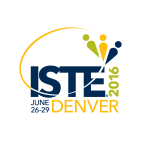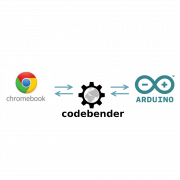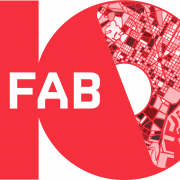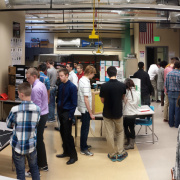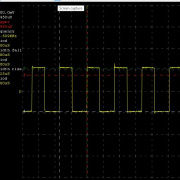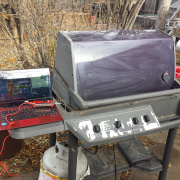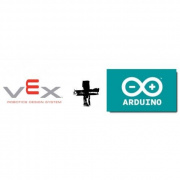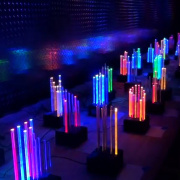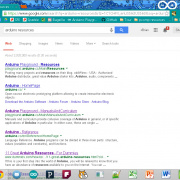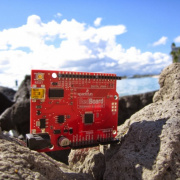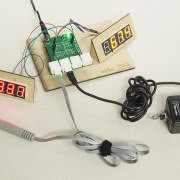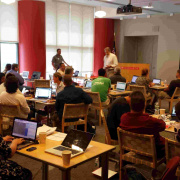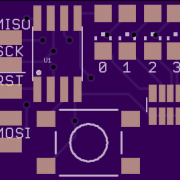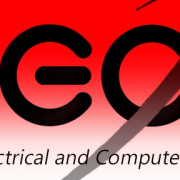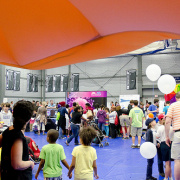bri_huang
Member Since: January 12, 2011
Country: United States
This was my first year at the International Society for Technology in Education (ISTE) conference, and it was amazing. Here's a quick re-cap of the events
With over 5 Million units sold in 2014 alone, Chromebooks are a growing trend among schools and homes. One of the biggest drawbacks to Chromebooks has been the inability to connect it to any hardware (i.e. Arduino) -- until now.
Courtesy of Terrence Fagan, Engineering Chair at Central Piedmont Community College. Terrence has done a lot of great work in engineering education and outreach in his community. He had the opportunity to attend the Fab10 Symposium in Barcelona last July. When he started telling me about his experience there, I felt it was a must for a blog post.
This Saturday was the kick-off for the 28th FIRST Robotics Competition. This competition has grown from a couple dozen schools to over 3000 teams internationally. This year, Sparkfun has reached out to help teams in this year's competition.
Last Friday at Skyline High School, rather than taking a traditional final exam, students in the Introduction to Electronics class with Ms. Vadovzski prepared poster presentations of projects that they created during the semester. Each project was required to demonstrate some type of interactivity using an Arduino and traditional electronics.
We often teach beginning learners that the standard 16 MHz Arduino Uno is fast... really fast. 16 MHz means 16 Million cycles per second -- or that translates to 1/16 millionths of a second per cycle. That's a mere 62.5 ns. That's fast. So, is the Arduino _really_ that fast? Let's see...
Happy Thanksgiving everyone! Check out this quick little hack using a standard temperature probe from my oven thermometer, our PicoBoard, and a little creative coding in Scratch!
Many schools and homes have VEX robotics systems. It's an awesome and amazing platform. I've casually mentioned to several friends that integrating VEX with Arduino is super simple to do... Here's a quick snap-shot at what we got working today.
Karen Brennan, Christan Balch, Michelle Chung recently authored a comprehensive guide for using Scratch in K-12 space. It covers everything from Getting Started to Creating Animations, Stories, Games, and even running your own "Hack-a-thon"
How to get more out of the things in your classroom. Lower cost alternatives for your classroom Arduino projects.
Back in January, we announced a small contest for teachers and educators using the SparkFun Inventor's Kit in their classes. We wanted to highlight and reward teachers for their hard work and dedication to promoting STEM education in the classroom.
On the third Thursday of every month, the Denver Museum of Nature and Science hosts an evening event for adults in the area called, Science Lounge. Their programming features live entertainment, demonstrations, hands-on demos, and an evening filled with science, education, and exploration! Each month features a different theme. For April, the Science Lounge theme was “Electrify!” What a perfect match for us here at SparkFun!
Our education team is headed to Boston this week for NSTA 2014. Please stop by our booth and see what we've got going!
A simple search on-line for "Arduino resources" results in "About 3,920,000 results (0.30 seconds)," but if you're just starting out and interested in getting Arduino into your classroom - this can be terribly overwhelming. So - here's a list of some of the sites I like to use.
In October, a team of Sparkfunions were blessed with the opportunity to head to our 50th state to teach Arduino to kids, teachers, and makers on the islands of Hawaii.
SparkFun EDU has a dedicated focus on K-12 education. We are showing several demos of our products, project ideas, and tutorials at the NSTA regional conference in Denver. Come visit us!
A friend of mine pointed me to this amazing graphic novel created by a former Olin graduate on the perspective of "What is Engineering"
One of the largest public school entities in the country kicked off a pilot program to integrate Software Engineering in grades 6 and 9 for 20 different schools. SparkFun was chosen to support their foray into embedded electronics, arduino, and eTextiles.
SparkFun EDU ran a 3 day short course for educators with Bollman tech building, making, and engineering using Arduino and other tools with microcontrollers.
A quick overview of a summer-camp program shared with us by one of our friends and followers of SparkFun EDU.
Reflection on an article about tech career advice from Google's top female executives
Trip report for our visit with the Hacker-Scouts program and the Parachute Factory in Las Vegas, New Mexico.
Getting Started with the SparkFun Inventor's Kit for Google's Science Journal App
May 24, 2016
This is a quick guide to using the Google Science Journal app with the Arduino 101 that's included and pre-programmed in the SIK for Google's Science Journal App.
Experiment Guide for RedBot with Shadow Chassis
May 28, 2015
This Experiment Guide offers nine experiments to get you started with the SparkFun RedBot. This guide is designed for those who are familiar with our SparkFun Inventor's Kit and want to take their robotics knowledge to the next level.
Using the SparkFun PicoBoard and Scratch
November 11, 2014
Here are a few tips in using the PicoBoard with Scratch v1.4. The PicoBoard allows us to write Scratch programs that interact with a variety of sensors on the PicoBoard. These sensors include: sound, light, a slider, a push button, and 4 external sensors (A, B, C, and D).
Re-Programming the LilyTiny / LilyTwinkle
September 11, 2014
A quick tutorial showing how to reprogram the ATtiny85 IC found on the LilyTiny or LilyTwinkle boards.
DigitalSandbox PicoBoard
August 15, 2014
This tutorial walks through how to upload code to your Digital Sandbox to emulate the functionality of the PicoBoard with Scratch.
Digital Sandbox Experiment Guide
July 31, 2014
Your guide to the Digital Sandbox! 16+ experiments that, using a graphical programming language, teach you to blink LEDs, monitor microphones, read temperature, and much more.
Simon Splosion Wireless
February 13, 2014
This is a tutorial demonstrating one of many techniques to "hack" the Simon Says. We will highlight the technique to take your Simon Says Wireless.
-
I love this breakout board, but I really wish SparkFun would sell this with female headers instead of male pins. We bought a class set of kits and ended up soldering new breakout boards with female headers. The female header is more similar experience to the interface of using Arduino!
-
Sharing a 3D baseplate holder I designed in SketchUp for the Pro Micro:
-
Mounting holes: 0.9" center-to-center
-
Double-check your Board and Port settings in Arduino. Please email our techsupport if you are still seeing problems with this. You can reach our entire team at: techsupport@sparkfun.com
-
Holes are sized for a 4-40. 2.3" x 2.1" center-to-center
-
The premise of the operation is this: * joystick controller is connected to your computer & your computer transmits wireless to the redboard arduino with an XBee * the redboard arduino receives the wireless signal through XBee * the signals received control the motors.
This uses a few libraries that I describe in the blog post -- unfortunately, I haven't written this up more formally. This blog continues to get a lot of traffic and views. I probably should write this up! :) Will definitely let everyone know as soon as it's completed.
-
The VSync library is available here on github: https://github.com/erniejunior/VSync. There are easier ways to implement this, but at the time VSync appeared to be one of the easier ways. Best of luck with your project!
-
Hi Dasien -
Here's a wishlist of parts that are used in the kit without the microphone and without the cardboard pieces. I did swap out the Micro USB Cable for a Raspberry Pi 5.25V Wall Adapter Power Supply. And, until we're able to fully secure a supply on the microphone, it's available on here on Amazon.
-
Thanks! We double-triple checked this, but something always gets missed. Fixing it now.
-
Hello!
If you use the Motor Controller 29, you can wire these directly up to the Arduino without an extra H-Bridge. The 3-wire Motor Controller 29 is essentially a built-in speed controller. It takes a PWM signal from the Arduino and then controls the motor's speed & direction based on this value.
If you're going to do this directly without the Motor Controller 29, then you'll need an H-Bridge. The Arduino can only source about 40 mA from any one of its pins. Motors need a LOT more than that. I hope that helps! Best of luck with your project.
